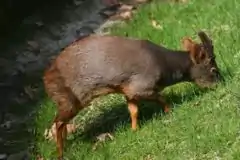| Pudu | |||
| J.E. Gray, 1852[1] | |||
 Przedstawiciel rodzaju – pudu południowy (P. puda) | |||
| Systematyka | |||
| Domena | |||
|---|---|---|---|
| Królestwo | |||
| Typ | |||
| Podtyp | |||
| Gromada | |||
| Podgromada | |||
| Infragromada | |||
| Rząd | |||
| Podrząd | |||
| Infrarząd | |||
| Rodzina | |||
| Podrodzina | |||
| Plemię | |||
| Rodzaj |
pudu | ||
| Typ nomenklatoryczny | |||
|
Capra puda G.I. Molina, 1782 | |||
| Synonimy | |||
|
| |||
| Gatunki | |||
| |||
Pudu[6] (Pudu) – rodzaj ssaków z podrodziny saren (Capreolinae) w obrębie rodziny jeleniowatych (Cervidae).
Zasięg występowania
Rodzaj obejmuje gatunki występujące w Ameryce Południowej[7][8][9].
Morfologia
Długość ciała 75–80 cm, długość ogona 3–4 cm, wysokość w kłębie 25–40 cm; długość poroża 5–10 cm; masa ciała 5–14 kg[8][10]. Rodzaj obejmuje jednych z najmniejszych przedstawicieli jeleniowatych, o krótkim porożu, ciemnym ubarwieniu i krępej sylwetce ciała z krótkimi kończynami.
Systematyka
Rodzaj zdefiniował w 1852 roku angielski zoolog John Edward Gray w artykule poświęconym nowemu gatunkowi jelenia opublikowanym na łamach Proceedings of the Zoological Society of London[1]. Na gatunek typowy Gray wyznaczył (oznaczenie monotypowe) pudu południowego (P. puda).
Etymologia
- Pudu (Pudua): epitet gatunkowy Capra pudu Molina, 1782; hiszp. pudú ‘jelonek’, od mapudungun pudu ‘jelonek’[11].
- Nanelaphus: gr. νανος nanos ‘karzeł’[12]; ελαφος elaphos ‘jeleń’[13]. Gatunek typowy (oznaczenie monotypowe): Capra puda G.I. Molina, 1782.
- Pudella: rodzaj Pudu J.E. Gray, 1852; łac. przyrostek zdrabniający -ella[5][14]. Gatunek typowy (oznaczenie monotypowe): Pudua mephistophiles de Winton, 1896.
Podział systematyczny
Do rodzaju należą następujące gatunki[7][15][6]:
- Pudu mephistophiles (de Winton, 1896) – pudu północny
- Pudu puda (G.I. Molina, 1782) – pudu południowy
Uwagi
Przypisy
- 1 2 J.E. Gray. Synopsis of the Species of Deer (Gervina), with the description of a New Species in the Gardens of the Society. „Proceedings of the Zoological Society of London”. 18, s. 242, 1850. (ang.).
- ↑ L.J.F.J.F. Fitzinger. Die Gattungen der Familie der Hirsche (Cervi) nach ihrer natürlichen Verwandtschaft. „Sitzungsberichte der Kaiserlichen Akademie der Wissenschaften. Mathematisch-Naturwissenschaftliche Classe”. Abt. 1 Mineralogie, Botanik, Zoologie, Geologie und Paläontologie. 68, s. 360, 1874. (niem.).
- ↑ A.H. Garrod. Notes on the visceral anatomy and osteology of the ruminants, with a suggestion regarding a method of expressing the relations of species by means of formulae. „Proceedings of the Zoological Society of London”. 1877 (1), s. 18, 1877. (ang.).
- ↑ V. Brooke. On the Classification of the Cervidœ, with a Synopsis of the existing Species. „Proceedings of the Zoological Society of London”. 1878 (2), s. 926, 1878. (ang.).
- 1 2 O. Thomas. On certain of the smaller south american cervidae. „The Annals and Magazine of Natural History”. Eight series. 11, s. 588, 1913. (ang.).
- 1 2 Nazwy zwyczajowe za: W. Cichocki, A. Ważna, J. Cichocki, E. Rajska-Jurgiel, A. Jasiński & W. Bogdanowicz: Polskie nazewnictwo ssaków świata. Warszawa: Muzeum i Instytut Zoologii PAN, 2015, s. 173. ISBN 978-83-88147-15-9. (pol. • ang.).
- 1 2 C.J. Burgin, D.E. Wilson, R.A. Mittermeier, A.B. Rylands, T.E. Lacher & W. Sechrest: Illustrated Checklist of the Mammals of the World. Cz. 2: Eulipotyphla to Carnivora. Barcelona: Lynx Edicions, 2020, s. 316. ISBN 978-84-16728-35-0. (ang.).
- 1 2 S. Mattioli: Family Cervidae (Deer). W: D.E. Wilson & R.A. Mittermeier (redaktorzy): Handbook of the Mammals of the World. Cz. 2: Hoofed Mammals. Barcelona: Lynx Edicions, 2011, s. 438. ISBN 978-84-96553-77-4. (ang.).
- ↑ D.E. Wilson & D.M. Reeder (redaktorzy): Genus Pudu. [w:] Mammal Species of the World. A Taxonomic and Geographic Reference (Wyd. 3) [on-line]. Johns Hopkins University Press, 2005. [dostęp 2021-04-10]. (ang.).
- ↑ Class Mammalia. W: Lynx Nature Books: All the Mammals of the World. Barcelona: Lynx Edicions, 2023, s. 594. ISBN 978-84-16728-66-4. (ang.).
- ↑ Palmer 1904 ↓, s. 597.
- ↑ Jaeger 1959 ↓, s. 163.
- ↑ Palmer 1904 ↓, s. 446.
- ↑ Jaeger 1959 ↓, s. 90.
- ↑ N. Upham, C. Burgin, J. Widness, M. Becker, C. Parker, S. Liphardt, I. Rochon & D. Huckaby: Treeview of Mammalian Taxonomy Hierarchy. [w:] ASM Mammal Diversity Database (Version 1.11) [on-line]. American Society of Mammalogists. [dostęp 2023-11-28]. (ang.).
Bibliografia
- T.S. Palmer. Index Generum Mammalium: a List of the Genera and Families of Mammals. „North American Fauna”. 23, s. 1–984, 1904. (ang.).
- E.C. Jaeger: Source-book of biological names and terms. Wyd. 3 (Revised second printing). Springfield: Charles C. Thomas, 1959, s. 1–316. (ang.).